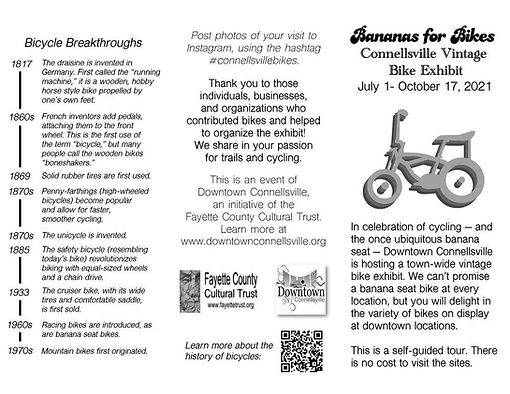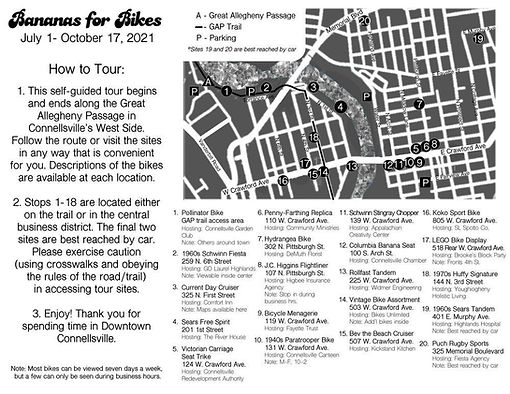
1. Pollinator Bike (Garden Display)
GAP Trail Access Area - Behind Martin's Plaza
Hosting: Connellsville Garden Club
2. 1960's Schwinn Fiesta (Inside Display)
259 North 6th Street
Hosting: Go Laurel Highlands (Visitors Center)
3. 2021 Day Cruiser (Inside Display)
325 North First Street
Hosting: Comfort In Hotel
Note: Maps are available here
4. Sears Free Spirit (Outside Display)
201 North First Street
Hosting: The River House
5. Victorian Carriage Seat Trike (Window Display)
124 West Crawford Avenue
Hosting: Connellsville Redevelopment Authority
Note: Bike belongs to the Fayette County Historical Society
6. Penny-Farthing Replica (Window Display)
110 West Crawford Avenue
Hosting: Connellsville Community Ministries
7. Hydrangea Bike (Window Display)
302 North Pittsburgh Street
Hosting: DeMuth Florist
8. J.C. Higgins Flightliner (Window Display)
107 North Pittsburgh Street
Hosting: Higbee Insurance
9. Micargi Mustang - GTS Stretch Beach Cruiser (Window Display)
Schwinn Shuffle Adult Scooter
Runt Just go Mini Clown Bike
Huffy Micro Circus Bike
119 West Crawford Avenue
Host: Fayette County Cultural Trust
10. 1940's Paratrooper Bike (Inside Display)
131 West Crawford Avenue
Host: Connellsville Canteen
Note: Open M-F 10 am - 2 pm
139 West Crawford Avenue
Hosting: Appalachian Creativity Center
Sponsor: Fayette County Cultural Trust
12. Columbia Banana Seat (Window Display)
100 South Arch Street
Host: Connellsville Chamber of Commerce
13. Rollfast Tandem (Window Display)
225 West Crawford Avenue
Hosting: Widmer Engineering
14. Vintage Bike Assortment (Inside Display)
503 West Crawford Avenue
Hosting: Bikes Unlimited
15. Bev the Beach Cruiser (Inside Display)
507 West Crawford Avenue
Hosting: Kickstand Kitchen
16. Koko Sport Bike (Window Display)
805 West Crawford Avenue
Hosting: SL Spotto Co.
17. LEGO Bike Display (Window Display)
518 Rear West Crawford Avenue (Fronts 4th Street)
Hosting: Brooke's Block Party
18. 1970's Huffy Signature (Outside Display)
144 North 3rd Street
Hosting: Youghiogheny Holistic Living
The next two displays are best reached by car:
19. 1960's Sears Tandem (Inside Hospital)
401 East Murphy Avenue
Hosting: Highlands Hospital
20. Puch Rugby Sports (Window Display)
325 Memorial Boulevard
Hosting: Fiesta Agency


The bicycle was invented in Mannheim, Germany over 200 years ago. Little is known about the world's first bicycle ride, 200 years ago on June 12th, 1817. Mannheim in southwestern Germany, and local aristocrat Baron Karl von Drais – then 32 – appeared in public, sitting on a wooden frame, with two wheels and an upholstered arm rest. Since then the bicycle has experienced a revolution, also with regard to social development.
Did you know bikes were invented because of a volcano eruption? After the volcano erupted, the climate changed; harvests failed and many horses – which in those days were not only used in farming but also served as a means of transport for people and goods – starved to death. Without these animals life became even more difficult than it already was. Then Karl Freiherr von Drais had an idea: In 1817 he invented the draisine, which was supposed to replace the horse but was so expensive that the majority of the population were unable to afford one.
Not until the beginning of the 1860s, when Pierre Michaux began developing bicycles with pedals. Michaux presented his invention in Paris at The International Exposition of 1867. It was an out-and-out success. Only the well-to-do bourgeoisie were able to afford bicycles. It was no different when the penny-farthing appeared on the market three years later with its large front wheel and small rear wheel.
This changed at the end of the 1870s with Harry John Lawson’s safety bicycle and John Boyd Dunlop’s air-filled rubber tire, which he invented around 1888: equally sized wheels, a chain drive to the rear wheel and the previously mentioned tires – that’s how bikes looked like then and that’s how they still look now. The beginning of the 20th century saw bikes being mass produced; they became affordable to all and evolved from a status symbol to an object of practical use for everyone.
For decades the bicycle was an important means of transport, though this changed with the economic boom of the 1950s: Motorbikes and cars quickly took hold and the only people who rode bikes were those who couldn’t afford a motor vehicle or those who didn’t have a driving license. The former status symbol now bore the reputation of being merely a poor man’s car.
The bicycle experienced a small boom at the end of the 1960s, when the banana bike and the fold-up bike were launched. Still, the focus remained on motorized transport and car-centric cities were the primary concern. This situation didn’t change until during the oil crisis in the 1970s. Ecological awareness developed and the bicycle began slowly to become important again, especially in an urban context. As a result of the rise of mountain biking in the 1980s and the emerging fitness movement, the interest in bicycle use continued to grow.
The bicycle is taking on an increasingly important role in urban spaces. The huge variety of models can be seen on the streets; folding bikes, cargo bikes and e-bikes have all become more and more popular over the past years. Long distances can be traveled in comfort with the help of electric motors, small folding bikes save space on the train and cargo bikes are ideal for carrying shopping. A lot can now be done without problems by bike. It brings movement into our lives, gives us freedom and is environmentally friendly.
The Fayette County Cultural Trust has partnered with Cycle Forward to do a bike exhibit starting on 1 July through 17 October. This exhibit, located in several storefronts and buildings, will feature vintage and present day bicycles.

